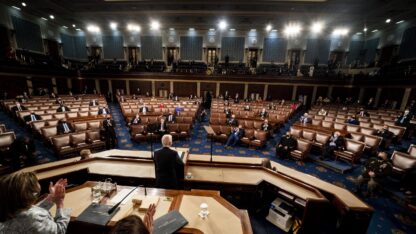President Biden will deliver his first State of the Union address on Tuesday night.
His message to the nation comes as the coronavirus pandemic is set to enter its third year and as Russia continues its march into Ukraine in what Biden says is an attempt to restore the fallen Soviet Union.
These issues are set against the backdrop of Biden’s very low poll numbers and a looming midterm election that will serve as the most tangible assessment of Americans’ faith in Biden and the Democratic Party.
Here’s what you need to know ahead of Tuesday night’s speech.
When is the State of the Union, and how can I watch it?
President Biden will deliver the State of the Union address on Tuesday at 9 p.m. ET.
NPR.org will provide live coverage and analysis of Biden’s address and the Republican response — as well as Texas’ primary election happening the same day.
You can listen to NPR’s simulcast of the event on NPR.org, on the NPR One app or on your local NPR member station. Find your station here.
What will Biden talk about?
The timing of this live speech coincides with a high-stress period for the nation, and as NPR senior editor and correspondent Ron Elving notes, during previous State of the Union addresses under similar circumstances, the tension and drama in the chamber can be almost palpable.
Top issues to expect in Biden’s address are his response to concerns about rising inflation and fatigue about the pandemic. With many Americans expressing growing malaise over years-long pandemic-related restrictions, officials across the country, including Democrats, have begun to relax guidance on prevention measures. On Friday the CDC relaxed its mask guidance for communities where hospitals aren’t under high strain.
The omicron surge is receding after a months as the dominant virus strain, and the White House has said that the nation is “moving towards a time when COVID isn’t a crisis.” Still, more than 900,000 Americans have already succumbed to the virus — more than 2,200 people every day.
Moving away from domestic issues, Biden is also expected to describe the steps his administration has taken to threaten Russia’s financial stability, which he has said will force Russian President Putin to reassess the cost he stands to incur if Russia’s military advance on Ukraine does not end.
The president has taken an increasingly stark tone in his assessment of Russia’s invasion of Ukraine, promising to impose on the Kremlin and its ranking class the most severe sanctions the nation has ever seen.
He’s also expected to talk about Judge Ketanji Brown Jackson, his pick to replace retiring Supreme Court Justice Stephen Breyer. Jackson is the first Black woman to be nominated to the high court; Democrats hope the speech will provide a lift among their supporters going into the midterms.
How will this speech differ from last year’s address?
In 2021, when Biden delivered his first joint address to Congress — a speech similar to the State of the Union address but given in the early days of a president’s term — the nation’s focus was overwhelmingly on the pandemic.
At the time, the usually crowded affair was capped at 200 attendees instead of the usual 1,600. That number includes members of both chambers of Congress and invited guests of the president and party leadership.
This year’s address will feel more familiar, at least in terms of size. The entire congressional body has been invited to attend, though guest attendance will remain prohibited as a coronavirus safety protocol.
Attendees of the March 1 event will need to submit a negative PCR test one day before the speech and wear “a high quality, properly fitted, medical-grade filtration mask (KN95 or N95) at all times,” according to a House Sergeant-at-Arms memo. They must also “adhere to social distancing guidelines regarding seating separation distances,” the memo said.
Separately, the U.S. Capitol Police will put up inner-perimeter fencing around the Capitol Building during the speech “out of an abundance of caution” amid the possibility of protests.
Who is delivering the Republican response?
Iowa Gov. Kim Reynolds will deliver the Republican Party’s response to Biden’s speech.
Reynolds, who will deliver the speech in Des Moines, gained national attention for her response to the coronavirus pandemic, which ran counter to many of the measures promoted by Biden’s White House.
While Democrats across the country espoused the importance of stay-at-home orders and statewide mask mandates, Reynolds was slow to impose coronavirus restrictions, rolled back pandemic safety protocols as early as February of last year and opposed vaccine mandates.
“Iowa Governor Kim Reynolds represents what it means to lead with conviction and true faith in our fellow citizens. … She handled COVID by choosing freedom over lockdowns and personal responsibility over mandates — leading to real economic recovery from the pandemic. She kept kids in school and critical race theory out,” House Minority Leader Kevin McCarthy said in a statement.
Copyright 2022 NPR. To see more, visit https://www.npr.org.
9(MDAxODM0MDY4MDEyMTY4NDA3MzI3YjkzMw004))

9(MDAxODM0MDY4MDEyMTY4NDA3MzI3YjkzMw004))








